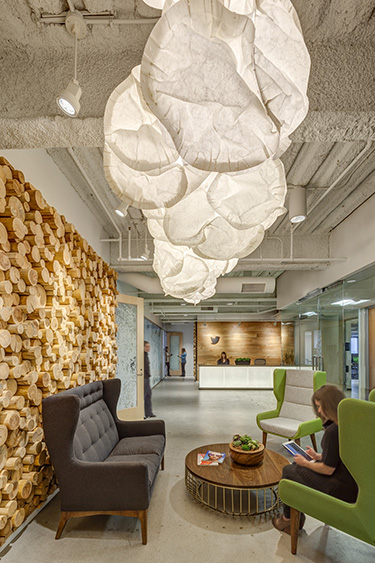|
Subscribe / Renew |
|
|
Contact Us |
|
| ► Subscribe to our Free Weekly Newsletter | |
| home | Welcome, sign in or click here to subscribe. | login |
Architecture & Engineering
| |
 |
October 26, 2017
Survey: IA Interior Architects
Specialty: First global firm focused exclusively on interior architecture; leads in workplace strategy and design, transforming organization culture and enhancing people’s lives
Management: Kim Parsley, managing principal, Seattle; David Kutsunai, managing principal, Seattle
Founded: 1984
Headquarters: San Francisco
2016 revenues: N/A
Projected 2017 revenues: N/A
Projects: Twitter, White Pages, Seattle; Travel Portland, Portland
Kim Parsley, managing principal, answered questions about her firm and the design industry.
Q: Since IA is nationwide, how do your Seattle and Portland offices decide which projects to pursue?
A: Our firm was founded on the concept of having the capability to deliver for our clients across the globe. We’ve established a very successful model that not only allows us to scale up or down when an opportunity presents itself, but also to leverage one of our global alliance firms when there is a need in a country where we don’t have an IA office. This is a network of like-minded firms who also design interiors.
Due to our experience of working globally, we have a good understanding of the differing expectations of project delivery — the level of design, the speed, the logistics, the cultural influences.
Q: The interior architecture field is highly competitive in the Northwest. How does IA differentiate itself?
A: As our name implies, IA’s strength is interiors. IA is the first and largest global architectural firm dedicated exclusively to the practice of interiors. We think about buildings from the inside-out, which has the greatest and most meaningful impact on people. We understand interiors better than anyone else and our team is comprised of individuals who have shaped their careers around how interior environments impact organizations — their people, customers, brand and bottom line.
Q: Which design field sectors perform well for your firm?
A: While our firm has historically focused on corporate interiors, we have developed expertise in other fields of interiors as well. Over the course of recent years, we’ve seen a refreshing new outlook for healthcare design. These clients are no longer only looking for firms who exclusively practice healthcare, but those who have a diverse background and draw from a broader design experience.
Secondly, the rumors that retail is dying are simply not true. This is an exciting time to be working alongside retailers who are, now more than ever, thinking not only about how they can draw customers to their brick-and-mortar shops but how their workplace exemplifies their brand. Because of tech infiltrating our lives, we believe we crave the interaction with others and the tactile side of consumer purchasing more than ever. These are very positive times for retailers to excite their customers with experiences they never imagined.
Q: Do some clients want to go beyond LEED for cutting-edge green designs?
A: Our clients in the Pacific Northwest have a very green-savvy set of employees. It’s no longer an aspirational story for them to be able to simply state they have certified their space under the LEED rating system. Our clients want to know the differences and benefits of LEED, Well Building Standard and the Living Building Challenge. We’ve worked with many of our clients to create their very own green guide, which aligns the team’s sustainable design pursuits (concepts taking from all three of these rating systems) with their corporate values.
Q: Is interior architecture regional in terms of clients’ tastes?
A: Overall, simply and generally, yes, regional sensitivity is extremely important. The strongest theme we see is for the design to be authentic and honest to its surroundings. This affects how we plan, design, curate and speak to all processes within our process. Furthermore, we see materiality based on the traditional outdoor activities we’re known for — more softwoods, more textured upholsteries, more warmth overall. We also get requests for punches of color to counteract our seasonal gray skies.
Q: How much gas is in the tank of the current development boom?
A: In Seattle, the majority of companies we work with are in expansion mode and planning for steady to robust future growth. The appetite for new construction remains unprecedented as many prominent local companies are looking for full or multi-building opportunities. All of this seems to bode well for continued development.
In Portland, clients continue to grow and new delivery of office space is well-balanced with current demand. While Portland tenants may not have the same insatiable appetite for new space that Seattle tenants have, the market continues to perform well.
Other Stories:
- Ice Box Challenge: a cool test of Passive House
- Survey: Code Unlimited
- Surveys: NAC Architecture
- Survey: AHBL
- Survey: Lemons Architecture
- Is growth only benefiting a small segment in Seattle?
- Rock wool’s new role: protecting exterior wood stud walls
- Get ready for the new year — and new energy codes
- After 10-year engagement, Kinects inverts ‘wedding cake’
- WSU cultural center: ‘How are you going to build this?’
- High-performance building? Start with early design analysis
- How ‘affordable’ housing is disappearing in Seattle
- How long will your AV last? Consider your cell phone
- Survey: Arup



